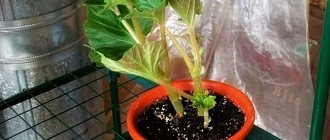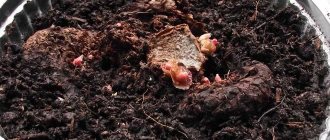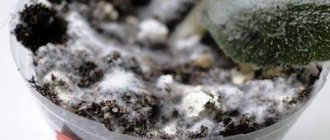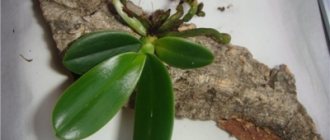The main thing we expect from flowering plants is the beauty of their flowering. But sooner or later this period ends, the buds wither, and only greenery remains.
Does active care for indoor flowers end here? What can be done at this moment so that the plant blooms again next year?
In this article we will analyze in detail the end of flowering, and learn how to properly care for it at this time. We will also look at the difference between tuberous begonia and those with ordinary roots.
general description
This plant is familiar to many, but not everyone knows how many varieties of begonia there are. Let's start with the fact that there are deciduous and ornamental species that are valued for the beauty of their leaves. The color of these plants is simply amazing: red, pink, purple, gray , almost black, various combinations of greenery, with contrasting edging, and a fancy pattern. The leaf shape is irregular, resembling an inverted drop, a circle with a wavy edge, or a maple leaf. The stems are fleshy and thick.
In this article we will talk about another variety - flowering begonia. This plant turned out to be excellent here too: red, yellow, purple, pink and white small flowers literally strew the compact bushes.
The natural habitat of these wonderful flowers is South America, Asia and Africa. They belong to the Begoniaceae family and have more than 1000 varieties. Named after the governor of Haiti, Michel Begon the Elder, who lived in the 17th century, when the begonia genus was discovered.
When and how long does it bloom?
The duration of flowering depends on several factors:
Plant varieties. Typically, simpler plants bloom longer than their double, large-flowered counterparts.- Care. If the necessary conditions are not provided (temperature, humidity, lighting, soil and pot) and there is no proper care (proper watering, fertilizing, pruning), flowering may be short-lived or not occur at all.
- Growing method. If you plant a plant in open ground, the flowering period will be limited in time due to weather conditions and the need to transplant it indoors. However, some species, such as ever-flowering begonia, after transplanting from open ground into a pot, bloom until spring. Tips for caring for begonias in a pot can be found in a separate article.
- Type of root system. Begonia has species with a tuberous root system and a regular one. The first ones bloom in the summer-autumn period, and the tubers must be dug up for the winter. The latter can bloom almost all year round.
- From the time of awakening. If the plant is dormant, then it all depends on when and how measures to awaken the plant are taken correctly. Usually they start doing this at the end of February. Then by April-May flowers will begin to appear.
You will learn about what to do if a flowering plant does not bloom in this article.
What is necessary?
Before proceeding directly to transplanting begonias, it is important to stock up on all the necessary components for this. These include several components
- Pot. It should not be too large and spacious. For young plants, you need to select containers 3-4 centimeters larger than the previous pots in which they are sold in stores.
- High-quality and suitable soil mixture. For begonia, the optimal mixture is a combination of peat, humus, turf and plain soil. All components must be taken in equal proportions.
- Good drainage. You should never forget about it if you want to create the most comfortable living conditions for the plant. For this purpose, various materials are used, for example, expanded clay, tiles, crushed stone or polystyrene foam cut into cubes.
These are all the necessary components that will be needed to properly transplant the begonia into a new container.
Peculiarities
Begonia has flowers of different sexes: there are female flowers with pistils, and male flowers with stamens. How to tell them apart:
- On the back side of the flower, female flowers have a bulge - the future seed capsule; male flowers have nothing there.
- Double flowers in the corresponding species can only be male; female flowers cannot be double. But male flowers, at the same time, can be simple.
- If you understand what pistils and stamens look like, you can simply see them. By the way, some double male flowers may have no stamens at all. It is the modified stamens that make the flower double.
Interesting fact! Removing female flowers from their very formation can significantly increase the flowering period of begonias, as well as increase its intensity. But only if you don't want to get seeds.
Plant during flowering
From the moment it awakens, the plant begins to accumulate strength and nutrients for the upcoming flowering.
Buds are laid and reproductive organs are formed. When the begonia is ready to reproduce, first the male and then the female flowers bloom. If pollination occurs, which is done by hand, then the male flowers wither, and in the female flower a fruit-box with seeds begins to ripen. This is the time of the highest activity of the plant.
At this time, a huge amount of nutrients and microelements is consumed. An accelerated metabolism requires more water, sunlight and heat.
Growing from a tuber
In autumn, the tubers should be removed from the ground, cleaned and stored all winter in sand or peat at a temperature of about 10 degrees. In February, the tubers must be planted in pots with moderate watering.
If you don’t have your own planting material, you can purchase it at the store. You need to choose tubers that have small sprouts.
Germination of tubers
Place the purchased tubers in a warm place in the light on a damp cloth and wait for small roots to appear and plant them in pots. The thickness of the soil above the tuber should be about 2 cm.
When the threat of frost has passed, begonias and pots can be planted in a flowerbed.
With the arrival of the first frost, flower pots should be moved indoors, the stems removed, and the pots should be placed in a cool place until spring and under no circumstances should they be watered.
Germination in a pot
When the first sprout appears from the pot in early spring, you need to lightly clean the tuber from the soil. This will make it easier for it to germinate.
You can also do this. The tuber needs to be cleared of old roots and planted in pots. We place the pots in the light and water them regularly. It is not advisable to cover the top of the tuber with soil. After 1.5-3 weeks it will sprout.
Tuber propagation
To increase the amount of planting material, the tuber can be divided into pieces. This is done when the sprouts grow to 5 cm. Then the cut areas should be sprinkled with crushed coal, dried, placed in pots again and wait for new sprouts.
Now we’ll tell you how to grow begonia from seeds.
What to do next with wilted buds?
Even during the period of active flowering, all faded buds are removed. Some carefully cut, others twist. This way you will gradually remove the entire flowering part, and by the end of flowering the question will disappear by itself. Why do this? During flowering in this way, you save the plant's energy for more luxuriant flowering. At the end of this period, you also help the plant get rid of unnecessary things in order to prepare for dormancy. And in the end, wilted flowers are not aesthetically pleasing; they spoil the appearance of the begonia, making it sloppy and unkempt.
For this purpose, the largest and healthiest fruits are left, the rest are cut off. 20-25 days after flowering ends, the capsule ripens. It is opened and the seeds are taken away. From these seeds you can grow new young plants using seedlings.
Kinds:
There are many types of begonias for home growing. These are various decorative deciduous, decorative flowering, tuberous begonias. Separately, it is necessary to highlight Begonia Elatior.
Flowering indoor begonia
How and when does Begonia bloom?
Amazing beauty pleases the eye when begonia blooms brightly and abundantly enough . Its luxurious flowers resemble buds of a rose, carnation or peony. They are simple and double , large and small , collected in racemose axillary inflorescences formed at the tips of the shoots. The perianth consists of 2-5, and in some species - 6-8 petals. The color scheme varies from white, yellow, pink, red to all sorts of transitional shades, two-tone with a border of flowers, providing a unique holiday atmosphere around you.
The many faces of elegant buds decorate your room from early June until September or from late spring to late autumn, depending on proper care.
Flowering period
The stage of active growth and flowering of the plant requires feeding at least once a week with complex mineral fertilizer. In this case, first a weak solution of potassium nitrate is added, and then everything else.
Begonia dormant period
At the end of flowering, the plant is prepared for the resting phase, gradually reducing the amount of watering until its above-ground part finally dries out. We remove everything that has dried , put the pot in a cool place, watering it occasionally. The temperature should not be higher than 10-12 degrees. The dormant period will last from November to March.
Begonia scent
Among the variety of plant varieties, there are both odorless and fragrant (Bauman's begonia).
Its smell is unique and even has medicinal properties . The invisible influence of begonia helps cleanse the bronchi, increases the vitality of the respiratory tract, and in itself is an excellent natural filter for people with nicotine addiction.
How does begonia bloom?
What to do after the begonia has bloomed?
After the plant has pleased you with lush flowering, you should definitely dry . We put it in a dark place for a month so that all the nutrients from the stems and roots go into the tuber. We dig it out 15 days after the upper part of the begonia, which is on the surface, has finally died off.
Do I need to prune begonias after flowering?
After completing the flowering stage, the plant needs pruning. At the same time, cut off the stems . This is necessary so that the flower gains strength and nutrients and has the opportunity to thank its owner in the future with a magnificent and fragrant bouquet of double begonia inflorescences.
Reproduction
Begonia is propagated by a variety of methods. To do this, cuttings or dividing the bush are used. This is also done with seeds.
Leaf cuttings
Most varieties of begonia are characterized by large and dense leaves. Therefore, they are propagated by cuttings, using a whole leaf or its fragment. In this case, it is worth cutting the main veins on the underside of the plate, laying it on wet sand and securing it. Moisten the soil through a tray.
After 2 months, roots will appear in the cut areas, and then new plants. When the culture gets stronger, it is moved to a separate container filled with a mixture of peat, soil and sand.
Stem cuttings
This is the simplest way in which the culture propagates. To do this, you should cut cuttings with 3-4 leaves from the plant and treat the cuts with charcoal. Place the material in a mixture of peat, leaf soil and sand. Place in a warm place with sufficient light.
It is recommended to water the crop moderately. Between moistening procedures, the soil should dry out a couple of centimeters. Rooting can be done directly in water. The roots will appear after about 1 month.
Dividing the bush
To implement this method, the plant should be pulled out of the ground in the spring and the roots divided into fragments with a sharp knife. Each of them must contain roots, at least 1 shoot or bud. Plant the shoots in different pots.
Growing from seeds
Seeds should be planted in winter in a special mixture of soil, sand, and peat. To improve seed germination, good lighting, optimal humidity and low air temperature are required.
It is important that the soil does not dry out. Before sprouts appear, the container can be covered with glass.
When seedlings appear, it is worth applying fertilizers containing nitrogen. Grown bushes are moved to separate containers.
Features of caring for begonia after flowering
It is not whimsical, but requires careful care, like any house plant, especially after flowering.
REFERENCE:
- the temperature should reach 18 degrees in winter and 20-25 in summer;
- enough light is needed. The best place is close to the window, but not exposed to direct sunlight;
- water as needed, more often in summer, less often in winter, when the soil dries to a depth of one or two centimeters;
- We use soft, settled water for irrigation;
- We create high air humidity - at least 50-60 percent.
Why doesn't indoor begonia bloom at home?
Reasons why begonia does not bloom
Most likely, it does not have enough light, the humidity is low, the temperature is not suitable, or you left it in a draft and overdid it with fertilizers.
Try to follow the care recommendations, change the location of the flower and the conditions of its maintenance: move it to another window sill or to a room where the temperature is suitable and there are no drafts.
How to make begonia bloom?
To ensure long and abundant flowering, they use the “short daylight” technique : for two weeks, the daylight hours are artificially reduced to 9 hours, covering the begonia with black film. Thus, the process of laying buds is activated. To prevent the plant from accelerating its growth in height at this time, it can be pinched 2-3 times. Then daylight hours double again. During the winter months, lighting is also necessary.
Compliance with the above rules of care will allow you to enjoy the luxurious beauty of flowering and enchanting aroma for as long as possible.
Take care of the begonia and take care of it, then the flower will bloom buds and smell, pleasing your eyes and smell!
Next you will see a photo of a blooming Begonia:
Pests
If no measures help to revive the plant, it is possible that parasites have appeared in the soil and are slowly eating the roots. In this case, take out an earthen ball with a rhizome, wash it in a solution of potassium permanganate and replant it in new soil.
The most common enemies of begonias are nematodes, spider mites, aphids, and thrips. Actellik is used against them, an insectoacaricide that simultaneously kills ticks and insects on shoots and in the ground.
Important! Spider mites are not insects, so conventional insecticides do not work against them.
At the same time, you should inspect the rest of the plants in the room. If the pests have managed to move in, all crops will have to be treated with Actellik. Spraying is carried out, the effect of which lasts 12 days, after which the treatment is repeated. It is permissible to carry out no more than two sprayings.
How to get rid of most types of weeds very quickly? Weeding will no longer be needed. New development from agronomists - here
Useful video
In these videos you can learn more about the flowering of Begonia:
https://youtu.be/Z8aO7IvNyYY
Useful material Below is a list of articles that may be of interest to you.
If you find an error, please select a piece of text and press Ctrl+Enter.
Begonia is a large genus of plants in the Begoniaceae family, including herbs, shrubs and subshrubs.
How long do begonias bloom? Expressive flowering of plants awaits caring gardeners and owners of indoor flowers. Activity can last up to 6-12 months, after which the plant requires rest to restore and accumulate organic matter. The appearance of buds is also influenced by the plant variety (there are varieties that bloom at certain times of the year and bloom all year round), the choice of soil and other care elements.
Plant varieties
What kind of begonias bloom? When studying varieties of plant crops, you can come across several classifications that allow you to more accurately determine the characteristics of a particular variety.
According to decorative properties, the following types are conventionally distinguished:
- decorative - deciduous;
- shrubby;
- tuberous;
- beautifully flowering.
Despite the abundance of colors and variants of shoot shapes, deciduous varieties are characterized by the appearance of small flowers, while flowering varieties can delight with the appearance of inflorescences of various sizes and shades.
Depending on the biorhythm, potted or growing plant crops need special care and conditions for planting and development.
Most varieties bloom at a certain age. This fact should be taken into account when purchasing small bushes with abundant flowering; as a rule, in such cases, specialized preparations were used in relation to the flower, provoking the appearance of buds ahead of schedule. Despite the number of inflorescences, the plant's activity quickly fades away, after which a long period of dormancy begins.
Popular varieties of begonias and their flowering times
How to determine how long indoor or garden begonia will bloom? The flower has many (more than one and a half thousand) varieties, but only 125 of them are grown to decorate the garden and the interior of the house. Also, for landscaping, various plant hybrids are grown, obtained through the hard work of gardeners.
The most common varieties and varieties of garden and house flowers:
Conditional view
Possible forms
Variety
Flowering time











